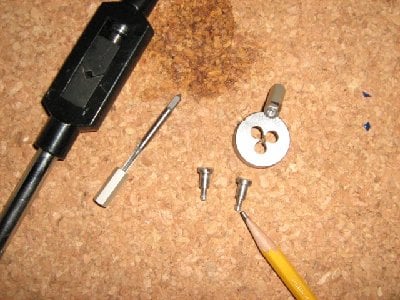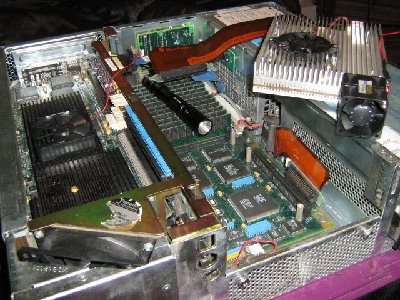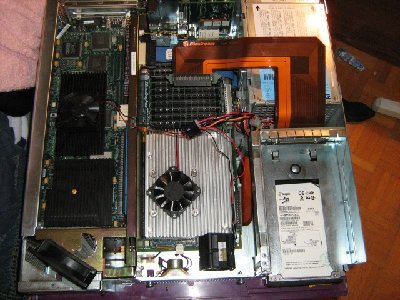Hi all
Ive got a question about over clocking (please read further) the cpu to 200 mhz . I can see it has been done but after checking out a few things I am more confused about what seems to be one small detail.
The german page ( http://hardware.majix.org/computers/sgi ... ning.shtml ) which involves removing & changing two resistors. One of the resistors is replaced with a 4.7 k ohm resistor. The thing which has caused me confusion is while I was reading a post about using a O2 cpu on a indigo2 question, and that answer is isn't possible for a number of reasons, different voltage being one of them, and now Im wondering if its such a good idea... sort of thing
On the german article it reads
Which makes me think ok, they are using a Octane cpu module, and the different resistor is to compensate for the voltage difference somewhere (although I don't think the resistor is handling the current, its too small, but thats all speculation.
... It also reads on the next line
Which makes me think were back to using a Indigo2 R10k/175 mhz cpu. So what one are we using ...*hmm*.
On the nekochan.net there is another example of the change, however two resistors are moved from the bottom to the top of the cpu module.
If this is the case and the resistors can be re-used, why did the other site not just re-use them. That's really what i'm wondering.
http://www.nekochan.net/wiki/gallery2/v/SGI_Photos/album56/
see
http://www.nekochan.net/wiki/gallery2/v/SGI_ ... k.jpg.html
and
http://www.nekochan.net/wiki/gallery2/v/SGI_ ... k.jpg.html
Does anyone have any experience doing this? Or insight on anything they have heard but I couldn't find during my searching?
Any info is appreciated
Thanks so much
Jonathan
Ive got a question about over clocking (please read further) the cpu to 200 mhz . I can see it has been done but after checking out a few things I am more confused about what seems to be one small detail.
The german page ( http://hardware.majix.org/computers/sgi ... ning.shtml ) which involves removing & changing two resistors. One of the resistors is replaced with a 4.7 k ohm resistor. The thing which has caused me confusion is while I was reading a post about using a O2 cpu on a indigo2 question, and that answer is isn't possible for a number of reasons, different voltage being one of them, and now Im wondering if its such a good idea... sort of thing

On the german article it reads
" This guide explains how to get a 200MHz CPU Octane R10000 work in an indigo ². This has been done and documented by Andre Schäfer . This has been done and documented by Andre Schaefer. Currently only a german Version is available. Currently only a german version is available."
Which makes me think ok, they are using a Octane cpu module, and the different resistor is to compensate for the voltage difference somewhere (although I don't think the resistor is handling the current, its too small, but thats all speculation.
... It also reads on the next line
Umbau eines Indigo2 R10k/175MHz CPU Moduls zu einem R10k/200MHz Rebuilding an Indigo2 R10k/175MHz CPU module to a R10k/200MHz
Which makes me think were back to using a Indigo2 R10k/175 mhz cpu. So what one are we using ...*hmm*.
On the nekochan.net there is another example of the change, however two resistors are moved from the bottom to the top of the cpu module.
If this is the case and the resistors can be re-used, why did the other site not just re-use them. That's really what i'm wondering.
http://www.nekochan.net/wiki/gallery2/v/SGI_Photos/album56/
see
http://www.nekochan.net/wiki/gallery2/v/SGI_ ... k.jpg.html
and
http://www.nekochan.net/wiki/gallery2/v/SGI_ ... k.jpg.html
Does anyone have any experience doing this? Or insight on anything they have heard but I couldn't find during my searching?
Any info is appreciated
Thanks so much
Jonathan
Indigo2 R10K 200 Mhz, 512 MB, Max Impact
O2 R12K 270 Mhz, 256 MB
Indy R5k 180 Mhz, XL24, 256MB
Sun Ultra1 Creator UltrasparcI 167 Mhz, 1 GB, 64bit, Custom Solaris 10 inst
Sun 280R dual 750 Mhz UltrasparcIII, 2GB
D1000 Disk array, LSI Logic FC array, Sun T3
Octane 195 Mhz single, mxe
Vax 4000 model 108, 256 mb
Alpha 500au, 18g, 512mb
O2 R12K 270 Mhz, 256 MB
Indy R5k 180 Mhz, XL24, 256MB
Sun Ultra1 Creator UltrasparcI 167 Mhz, 1 GB, 64bit, Custom Solaris 10 inst
Sun 280R dual 750 Mhz UltrasparcIII, 2GB
D1000 Disk array, LSI Logic FC array, Sun T3
Octane 195 Mhz single, mxe
Vax 4000 model 108, 256 mb
Alpha 500au, 18g, 512mb









 (single-CM)
(single-CM)

 Or are they both the same
Or are they both the same






 that was it, and this can be one improvement worth future exploration ...
that was it, and this can be one improvement worth future exploration ...
 ? probably not ... yes ? who knows ... maybe ... that will be one REAL improvement ...
? probably not ... yes ? who knows ... maybe ... that will be one REAL improvement ...







 I guarantee you it puts out two or three times more heat than Solid Impact. It's the sort of thing that noticeably warms up the room it's in. The fan in the graphics card cage can keep up with that, plus whatever you have installed in the fourth slot. OK,
I guarantee you it puts out two or three times more heat than Solid Impact. It's the sort of thing that noticeably warms up the room it's in. The fan in the graphics card cage can keep up with that, plus whatever you have installed in the fourth slot. OK,

